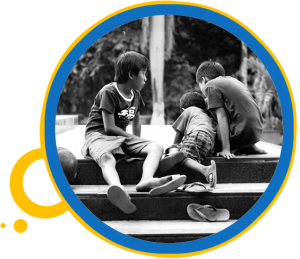The primary behaviors associated with ADHD are inattention, hyperactivity, and impulsivity.
The headings below describe each of these behaviors and their symptoms.
1. Inattention
Children with ADHD can have difficulty with one or all parts of the attention process. Some children may have difficulty concentrating on tasks— particularly those that are routine or boring.
Others may have trouble knowing where to start a task. Still others may get lost in the directions along the way. A careful observer can watch and see where the attention process breaks down for a particular child.
Symptoms of inattention:
- Poor attention to details
- Makes careless mistakes in schoolwork, or other activities
- Difficulty maintaining attention during tasks or play activities
- Does not seem to listen when spoken to directly
- Does not follow through on instructions— not due to oppositional behavior or failure to understand instructions
- Difficulty organizing tasks and activities
- Avoids, dislikes, or is reluctant to engage in tasks that require sustained mental effort—such as schoolwork or homework
- Loses things necessary for tasks or activities— such as toys, school assignments, pencils, books, or tools
- Easily distracted by extraneous stimuli
- Forgetful in daily activities
2. Hyperactivity
Excessive activity is the most visible sign of ADHD. The hyperactive toddler/preschooler is generally described as “always on the go” or “motor driven.” With age, activity levels may diminish. By adolescence and adulthood, the overactivity may appear as restless, fidgety behavior.
Symptoms of hyperactivity:
- Fidgets with hands or feet, or squirms in seat
- Leaves seat in classroom or in other situations without permission
- Runs or climbs excessively in situations in which it is inappropriate
- Difficulty playing or engaging in leisure activities quietly
- Talks excessively
3. Impulsivity
Children with ADHD act before thinking, because they have difficulty waiting or delaying gratification. The impulsivity leads these children to speak out of turn, interrupt others, and engage in what looks like risk-taking behavior. The child may run across the street without looking, or climb to the top of very tall trees.
Symptoms of impulsivity:
- Blurts out answers before questions have been completed
- Difficulty awaiting turn
- Interrupts conversations or intrudes on games
Contact a vision therapy eye doctor near you if your child is showing signs of ADHD, as a vision problem may be causing these behaviors.
SEE RELATED: Boys, ADHD and Brain Injuries
Don’t all children show these signs occasionally?
From time to time, all children will be inattentive, impulsive, and overly active.
In the case of ADHD, these behaviors are the rule, not the exception. When a child exhibits the behaviors of ADHD, even if they do so consistently— do not draw the conclusion that the child has the disorder!
Until a proper evaluation is completed, you can only assume that the child might have ADHD. Conversely, people have been known to read symptom lists and, finding one or two exceptions, rule out the possibility of the disorder’s presence.
ADHD is a disability that, without proper identification and management, can have long-term complications. Parents and teachers are cautioned against making the diagnosis by themselves.
How do I know for sure if my child has ADHD?
Unfortunately, diagnosing ADHD is complicated and much like putting together a puzzle.
An accurate diagnosis requires an assessment conducted by a well-trained professional, usually a developmental pediatrician, child psychologist, child psychiatrist, or pediatric neurologist, all knowledgeable about ADHD and all other disorders that can have symptoms similar to those found in ADHD.
The ADHD diagnosis is made on the basis of observable behavioral symptoms in multiple settings.
This means that the person doing the evaluation must use multiple sources to collect the information needed.
A proper ADHD diagnostic evaluation includes the following elements:
- A thorough medical and family history
- A physical examination
- Interviews with the parents, the child, and the child’s teacher(s)
- Behavior rating scales completed by parents and teacher(s)
- Observation of the child
- A variety of psychological tests to measure I.Q. and social and emotional adjustment, as well as to indicate the presence of specific learning disabilities.
Clearly, diagnosis is not as simple as reading a symptom list and saying, “This child has ADHD”.
If you think your child may be showing signs of ADHD, discuss your concerns with your pediatrician. Your doctor will be able to explain how to effectively diagnose and treat any problems related to your child’s health.
Important note: Many symptoms of ADHD can actually overlap with behaviors that result from an undiagnosed vision problem, most commonly Convergence Insufficiency.
LEARN MORE: Guide to Vision Therapy for ADHD
Before labeling your child with ADHD, it is strongly encouraged that you to schedule a comprehensive vision evaluation with an experienced eye doctor.










